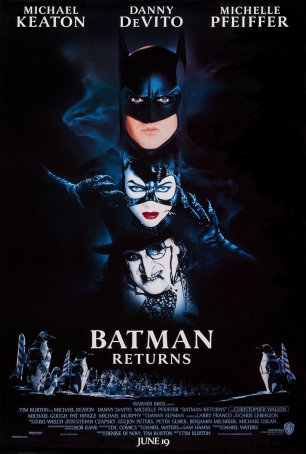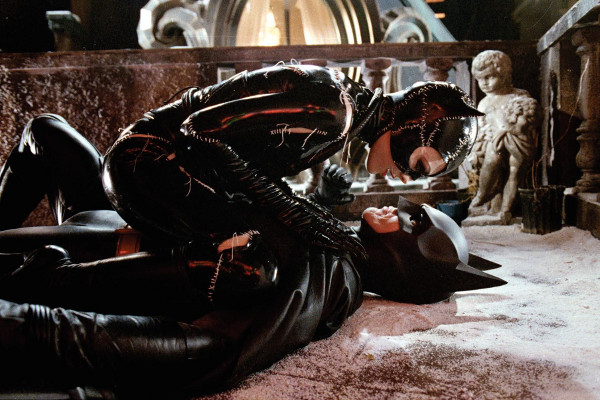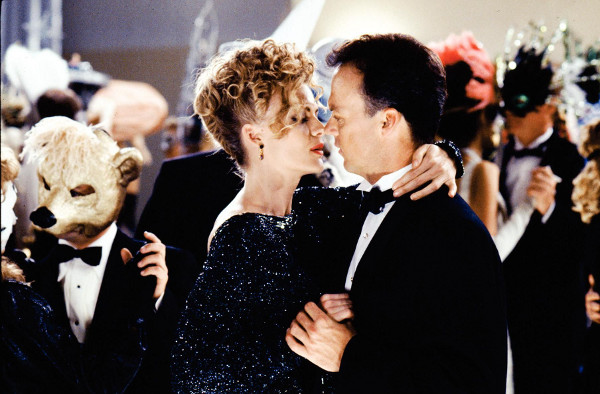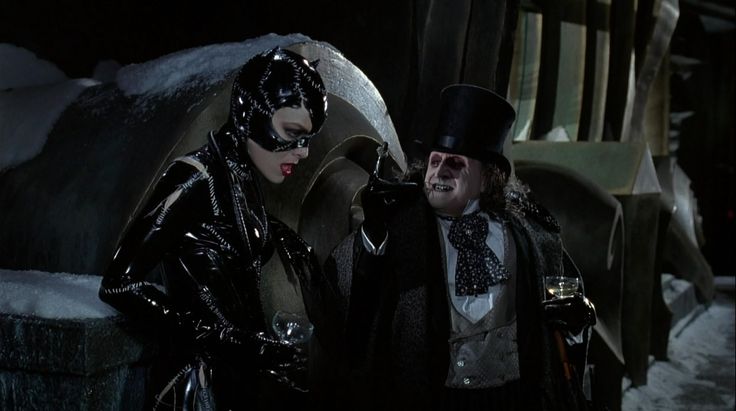Batman Returns (United States, 1992)
April 11, 2024
The box office performance of Tim Burton’s 1989 Batman assured there would be sequel but Burton’s desire for greater creative control caused the production of Batman Returns to linger in development longer than Warner Brothers preferred. In addition to cycling through several variations of the screenplay (the shooting script, despite being solely credited to Daniel Waters, was actually an amalgamation of at least three separate drafts plus various uncredited rewrites), Burton was plagued with several potential defections. Michael Keaton was initially reluctant to return to the title role, although a hefty raise diminished many of his objections. Danny Elfman, miffed over the prominence of Prince’s contributions to Batman, needed personal assurances from frequent collaborator Burton before signing on the dotted line.
Of the original four ‘80s/’90s Batman movies, Batman Returns is the best, edging out the more flamboyant Batman Forever and easily moving beyond the Joker-centric Batman and the infamously awful Batman & Robin. Keaton is more comfortable in the role, both with and without the mask. Michelle Pfeiffer is a significant upgrade over Kim Basinger and, unlike with Batman’s leading lady, there are genuine sparks. Danny DeVito’s Penguin is a more nuanced villain than the bad-to-the-bone Joker and DeVito doesn’t feel the same need as Jack Nicholson to steal every scene (although Christopher Walken does a fair amount of mugging for the camera).
Batman Returns ups the ante from the first film. This time around, there are three villains instead of one. Two are staples of Batman lore: The Penguin and Catwoman. The third, Max Shreck, is a creation of the film. The screenplay provides abbreviated origin stories for Penguin (how the deformed baby Oswald Cobblepot was thrown into the sewers and raised by penguins) and Catwoman (how the meek secretary Selina Kyle escapes death with a vengeance-tinged perspective – “Life’s a bitch, now so am I.”). Shreck, a greedy, amoral businessman, needs no backstory. The Penguin and Catwoman come across as tragic, almost-sympathetic figures. Not so much for Shreck.
 As for Bruce Wayne/Batman, Keaton portrays him as being
haunted by the possibility that his alter-ego may be more harmful than beneficial
to the people of Gotham City. Although Vicki Vale (Basinger’s character in Batman)
doesn’t appear in the film, her parting words to Bruce (as relayed by him to
Selina Kyle) are among the most salient bits of dialogue in the film. Had
Burton and Keaton re-teamed for what became Batman Forever, this narrative
element (which Joel Schumacher ignored) would likely have been pursued.
Christopher Nolan came back to it in The Dark Knight Rises.
As for Bruce Wayne/Batman, Keaton portrays him as being
haunted by the possibility that his alter-ego may be more harmful than beneficial
to the people of Gotham City. Although Vicki Vale (Basinger’s character in Batman)
doesn’t appear in the film, her parting words to Bruce (as relayed by him to
Selina Kyle) are among the most salient bits of dialogue in the film. Had
Burton and Keaton re-teamed for what became Batman Forever, this narrative
element (which Joel Schumacher ignored) would likely have been pursued.
Christopher Nolan came back to it in The Dark Knight Rises.
The central antagonist in Batman Returns is The Penguin, whose end-game is to kidnap and murder the first-born of every prominent citizen in Gotham City as a means of revenge for what was done to him as a child. Before implementing that plan, he spearheads a terrorist attack and then, with the backing of Shreck’s deep pockets, runs for mayor. Ultimately, he has two goals: eliminating Batman and avenging himself on Gotham City (not necessarily in that order). Meanwhile, Catwoman comes into the story tangentially. After Shreck pushes her out a window, she inexplicably survives thanks to the nurturing of a large number of cats. Thereafter, she assembles a skintight latex outfit and becomes briefly allied with The Penguin when she believes he can help her achieve her personal goal of killing Shreck.
One of the best elements of Batman Returns is the whirlwind romance between Bruce and Selina, who spar with each other in costume and dance with their masks off. The chemistry between them generates sparks and the moment when they simultaneously realize the truth about one another is priceless – probably the best scene in the movie. (“Oh my God. Does this mean we have to start fighting?”)
 Although Batman Returns is tonally lighter than its
predecessor, the film nevertheless exists in the shadows. It’s also weirder, an
indication of Burton exerting stronger creative control. The film’s look owes a
debt to German Expressionism, something made explicit in naming a character “Max
Shreck,” a reference to silent film actor Max Schreck, who is best known for
playing the emaciated Count Orlock in F.W. Murnau’s 1922 classic, Nosferatu.
The film’s Christmas setting offers a gothic slant to the holiday, a possible
foreshadowing of Burton’s upcoming collaboration with Henry Selick, The Nightmare Before Christmas, which was in production simultaneously with Batman
Returns.
Although Batman Returns is tonally lighter than its
predecessor, the film nevertheless exists in the shadows. It’s also weirder, an
indication of Burton exerting stronger creative control. The film’s look owes a
debt to German Expressionism, something made explicit in naming a character “Max
Shreck,” a reference to silent film actor Max Schreck, who is best known for
playing the emaciated Count Orlock in F.W. Murnau’s 1922 classic, Nosferatu.
The film’s Christmas setting offers a gothic slant to the holiday, a possible
foreshadowing of Burton’s upcoming collaboration with Henry Selick, The Nightmare Before Christmas, which was in production simultaneously with Batman
Returns.
There’s less action in Batman Returns than in Batman, but there’s violence aplenty. Batman remains an elusive figure, mostly staying in the shadows. One of the contemporaneous complaints about the film was the lack of a focused, action-oriented climax but, in retrospect, that represents a strength, helping Batman Returns seem less like a cookie-cutter comic book movie and more like something with its own identity. Unlike the other two sequels, this one doesn’t seem committed to selling toys. In terms of marketing, the only major deal was with McDonald’s, which sold a Batman Returns Happy Meal coinciding with the film’s release. This caused a minor controversy when watchdog groups pointed out the inappropriateness of the production’s material for young children. Although rated PG-13, it skated close to the boundaries of an R with blatant sexual double-entendres and a matter-of-fact attitude toward violence.
 Each member of the Trio of Nastiness brings something
different to the proceedings. DeVito’s Penguin couldn’t be more different than
the Burgess Meredith interpretation in the Adam West TV show. Although possessing
a warped comedic edge, this villain is best remembered for the extensive
prosthetics that made him frightening to some small children. Michelle Pfeffer’s
catsuit became iconic (although she hated wearing it) and her character is the embodiment
of BDSM. Latex and whips – what could be more obvious? As for Shreck, he’s
Christopher Walken in his creepy prime. Burton later admitted almost not casting
him because he found the actor to be intimidating.
Each member of the Trio of Nastiness brings something
different to the proceedings. DeVito’s Penguin couldn’t be more different than
the Burgess Meredith interpretation in the Adam West TV show. Although possessing
a warped comedic edge, this villain is best remembered for the extensive
prosthetics that made him frightening to some small children. Michelle Pfeffer’s
catsuit became iconic (although she hated wearing it) and her character is the embodiment
of BDSM. Latex and whips – what could be more obvious? As for Shreck, he’s
Christopher Walken in his creepy prime. Burton later admitted almost not casting
him because he found the actor to be intimidating.
The passage of time has been kind to Batman Returns. Upon its initial release, it was greeting with a mixed reaction by critics and movie-goers. The box office, although buoyant during its first weekend, ultimately disappointed (resulting in Warner Brothers deciding not to offer Burton the director’s chair for the third Batman movie). Now, some three-plus decades later, this is generally viewed not only as the best of the Burton/Schumacher series but one of the best superhero movies of the century. Whether watched as an alternative Christmas movie or at any other time of the year, Batman Returns illustrates offbeat possibilities that were once possible in the superhero genre. The Burton aesthetic remains Batman Returns’ most memorable aspect and one reason why the film’s reputation has escalated during its history on home video.
Batman Returns (United States, 1992)
Cast: Michael Keaton, Danny DeVito, Michelle Pfeiffer, Christopher Walken, Michael Gough, Michael Murphy, Pat Hingle
Home Release Date: 2024-04-11
Screenplay: Daniel Waters, based on characters created by Bob Kane
Cinematography: Stefan Czapsky
Music: Danny Elfman
U.S. Distributor: Warner Brothers
U.S. Home Release Date: 2024-04-11
MPAA Rating: "PG-13" (Violence, Sexual Content)
Genre: Action/Adventure
Subtitles: none
Theatrical Aspect Ratio: 1.85:1
Comments